#out of left field when i have katniss on here BUT i love your modern verse
Explore tagged Tumblr posts
Text
@inbreeze gets nancy drew !
it's a cute little town - - - at least there's that. nancy has been stranded in way worse places. and there's a library that looks pretty open, so she pushes the door and looks for a friendly face. looks can always be deceiving, of course, but if one thing has always held true in nancy's life it's that small town librarians are pretty good people. library volunteers, too, she doesn't judge.
"hey, sorry," a hand swipes cooling sweat ( thank god for air conditioning ) from her forehead and a red ponytail swings behind her head as nancy smiles at the woman behind the desk, "this is not at all a library question, but is there a good tow company in town? my car broke down down the street."
#inbreeze#* nancy ; answered#out of left field when i have katniss on here BUT i love your modern verse#and i feel like sleuth nancy interacting with mysteriously vanished rising star lucy gray is a breeding ground for fun
5 notes
·
View notes
Text
You’re (Probably) Drawing Archers Wrong
Hello, my name is Len and I’ve shot archery as a hobby for as long as I can remember. I have a problem: fanart depicting archery is oftentimes Very Wrong! I feel like most of this stems from not using good reference pictures, and from a general lack of knowledge. So, I wanted to create a post for anyone interested in accurately drawing an archer! Disclaimer: this is not a comprehensive post or a tutorial on how to shoot, and is intended for artists. That said, if you’re interested in archery, you may still find value in this post, though I recommend doing your own research. I’m certain there will be errors here considering I do this as a hobby not a profession, and I welcome corrections. Finally, archery can be dangerous, and even if you don’t read any more of this post, PLEASE read the safety section.
Safety
This part is going to be a PSA, because the thought of someone reading my post, getting into archery themselves, and doing these things? It terrifies me. So, rules number one, two, and three are: never aim at another person (duh), never use a damaged bow or arrows, and never, NEVER dry fire a bow. Dry firing means drawing back and releasing the string without an arrow. This can make your bow EXPLODE. It can hurt you, and even if your bow doesn’t explode, it’s fucked it up so bad that you should never shoot that bow again. Don’t do it, and don’t draw art of people doing it. Okay, PSA done, now onto the rest of the post.
There’s a TL;DR at the bottom!
First thing’s fist: the equipment! Archery requires four things: a bow, a quiver, arrows, and protective equipment (which is usually what I see most posts lacking). The first thing you should do before you draw your archer is decide what type of bow to give them. I’m not covering crossbows because I’ve only shot one once and I also Hate Them. There are three main types of bows: longbows, recurves, and compounds.
Bows
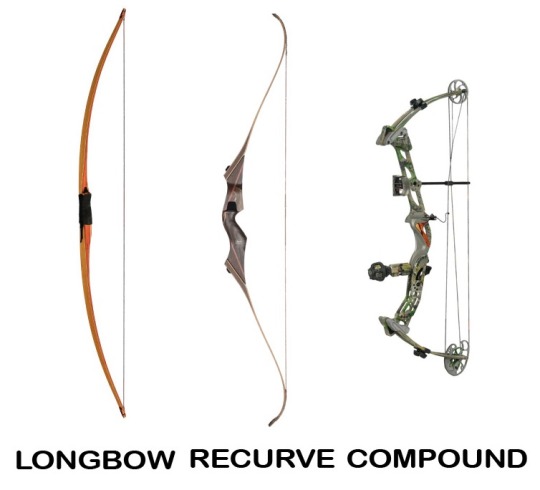
There are two different types of bows that are commonly called a longbow: English longbows, and flatbows (yes I’m considering flatbows a type of longbow to simplify things). English longbows are very large and have a very high draw weight (which means it’s hard to pull the sting back). These were used mainly by the English in the Middle Ages. Flatbows are typically smaller and have a lower draw weight as well as a slightly different profile. These were mainly used by Native American tribes such as the Hupa, the Karuk, and the Wampanoag, as well as prehistoric Europeans and the Finnish, among others. It is often seen in historical fiction and fantasy, and the English longbow is usually depicted as Robin Hood’s preferred bow type. I believe Katniss uses a flatbow in the beginning of Hunger Games, but don’t quote me on that.
Recurves have limbs that curve outwards and are smaller than longbows. Many, many cultures have used these, including but not limited to certain West-coast Native American tribes, the Mongols, the Scythians, the Greeks, the Turks, the Koreans, and the Chinese. Recurves can be made of either wood or of a combination of wood, horn, and glue, making them either composite or non-composite. These are the bows you typically see mounted archers using, and are often used in competitions today. It’s commonly seen in fantasy, and is the bow type used by Legolas, Tauriel, Katniss Everdeen in Mockingjay, Merida, Green Arrow has a lever action, and Hawkeye uses a silly collapsible one.
Compound bows are the most commonly used bow among hunters, are almost always made of fiberglass and either carbon fiber or aluminum, are Technical Looking, and pack the biggest punch for the least amount of effort. It’s a modern invention used worldwide. I don’t know where else to put this, but almost everyone who I know that shoots a compound uses something called a trigger release (pictured below) to draw back the string because it means your release is cleaner.

So, those are the main types of bow! Google which bow would be appropriat for the era and region your character is from, or if they’re from space or an alternate dimension, pick whichever you think fits the character the best.
Quivers
There are two types of quiver: back quivers, like Legolas wears, and hip quivers, like those used in the Olympics. Which quiver you should use varies from culture to culture and time period to time period. If it’s fantasy, set in modern day, or set in the future, you can chose whichever you prefer.
Arrows
Arrows can have shafts of wood or fiberglass, can have real feathers or synthetic for fletching, and can have countless different types of heads. The main two that are in use today are called field points and broadheads, and most commercial arrow shafts allow you to freely switch them out.
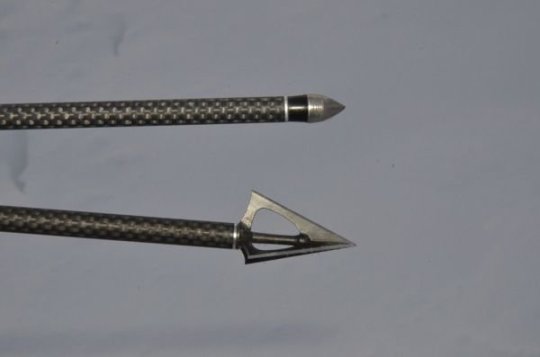
The arrow on the top is a field point, used only for target practice, and the arrow on the bottom is a broadhead, used only for hunting or war. You never hunt with a field point, and never practice with a broadhead. Basically every fictional character out there is shooting to kill, so they’ll all use either a broadhead, or a culturally appropriate variation of deadly arrowhead (bodkin, scythian, flint, etc). Do your research! A Native American wouldn’t use a bodkin, and a Scythian wouldn’t use a flint arrowhead!
Protective Equipment
The one really necessary piece of protective equipment is hand protection. If your character uses a three fingered draw or a pinch draw (we’ll speak on draws later), they need either an archery tab, or an archery glove. If your character is using a thumb draw, they need a thumb ring. These three pieces of equipment keep archers from getting blisters and damaged skin.
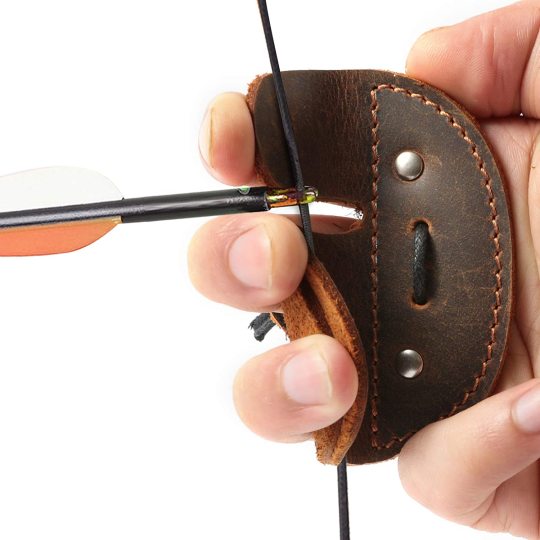
This is a tab.

This is the type of glove that I use. All an archery glove needs to do is protect your three draw fingers, but it can be more traditionally glove-like than this one. I’ve even seen ones that are a combination leather bracer and archery glove that give big Fantasy Vibes.
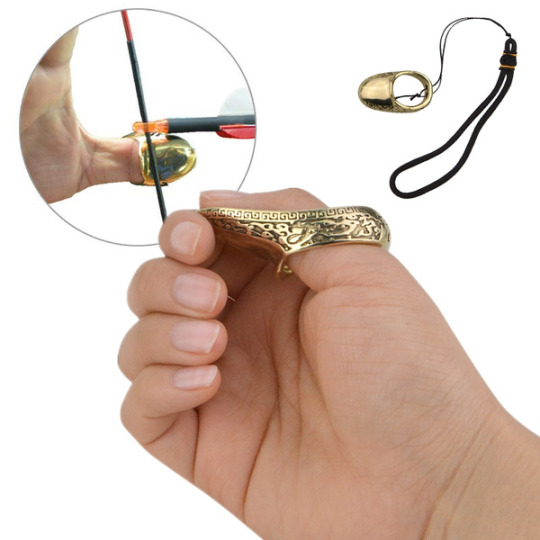
This is a ring. Some historical ones can get REAL ornate and pretty.
Another piece of protective equipment that is commonly used is an arm guard or a bracer. Not everyone uses one, because if your form is good the string should not be hitting your arm, so you can get away with not giving your character one. They can vary in style from something like the more minimal one below up to a full leather bracer.
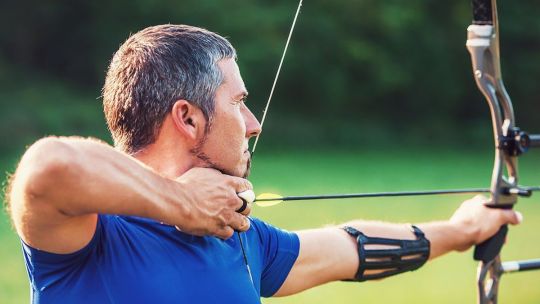
Form
Form can vary greatly and I’m not about to diss other archery disciplines especially ones I’m ignorant on, so just know that not every culture has the same form. I’m just going to cover a few cultures’ variations, and what I’ve been taught by 21st century Midwest archers. There are several aspects to form, as form is just another term for “everything pertaining to how you shoot”. I’m going to break it down into stance, posture, draw, elbow discipline, holding the bow, and anchor. These are not the only aspects of form (there’s aiming, release, and breath control), but these are the only relevant aspects to drawing archers. I will not be covering mounted archery because I’m sadly ignorant on the topic. I recommend doing your own research and looking into Mongolian mounted archery.
Stance
The thing all stances have in common is that you should put your feet a shoulder-length apart, balance your weight equally between both feet, keep your knees slightly bent, and stand facing approximately 90 degrees away from your target. There are three stances that are common that I’m aware of: squared, open, and closed.

Squared stance means keeping both feet squared up to an imaginary line. Open means that you’re facing slightly towards the target. Closed means you’re facing slightly away. I vary between square and open, and to be honest I’ve never noticed a difference. So long as you draw your character standing with a stable stance, facing away from the target, you should be good.
Posture
Your posture should be with your back straight, your hips squared, and should never have you leaning. Below is one of my favorite archery pictures, not only because I love Marilyn, but because it is a great illustration of what not to do posture wise.
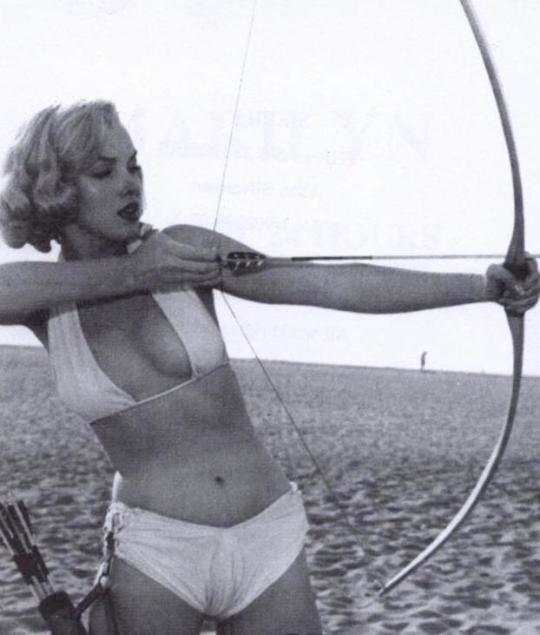
See how she’s leaning back? Yeah, don’t draw your character like that, it looks foolish.
Draw
There are four different types of draw that I’m aware of, I’m educated on three, and I have experience with one (though I’m itching to learn to thumb draw). The types of draw are three fingered draw, otherwise known as Mediterranean draw, pinch draw, thumb draw aka Mongolian draw, and Japanese draw, or torikake. I know fuck all about Japanese draws, so I’m not going to speak out of my ass on topics I don’t understand (if anyone reading practices traditional Japanese archery I would love if you chimed in!). I highly recommend doing your own research on which civilization your character comes from and which draw they use, especially if it’s Japanese because I’m not covering that here.

First up is three-fingered. This is the draw I use, and it’s the most common draw in my limited experience in the Midwestern archery community. It is common in Europe and the Middle East. It requires you to use three fingers, partially wrapped around the string. You do not pinch the arrow. Most people place their index finger above the arrow and their middle and ring finger below, though I’ve seen all different variations. If your character is right handed and uses this draw, draw the arrow on the left side of the bow. Lefties do the inverse, and make sure and draw a left handed bow while you’re at it.
Next is the pinch draw. I’ve never shot with this, nor seen it used. It was common in the Americas and for a time in Ancient Greece. You’re supposed to physically pinch the arrow between your thumb and index finger. Your character would need a full archery glove if you draw them with this grip. The release is supposed to be smooth because there’s only one point of contact, rather than three. I believe you would place the arrow on the right side of the bow when using this technique, but I cannot speak with certainty as I’ve never seen it done (again, lefties would do the opposite).
Last but not least is the thumb or Mongolian draw, though it is/was also widespread in Korea, China, Russia, Persia, Turkey, and the Roman and Byzantine Empires. In this draw you wrap your thumb completely around the string and tuck it behind your other fingers. You do not grab the arrow. This draw utilizes your strongest digit, and so it may be less strenuous than other draws. This draw is commonly used with mounted archery. If your character is right handed and using this draw, put the arrow on the right side of the bow (lefties, do the inverse).
Elbows
Another aspect of your draw that is important is elbow discipline. The elbow of your character’s string hand should not point up into the air. It should point straight back, like the picture below.
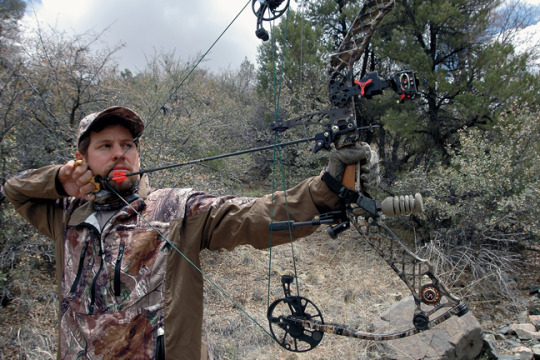
Now, the other elbow is important, too. Don’t draw them with a locked elbow, instead keep it slightly bent and rotated inwards, like the picture below.
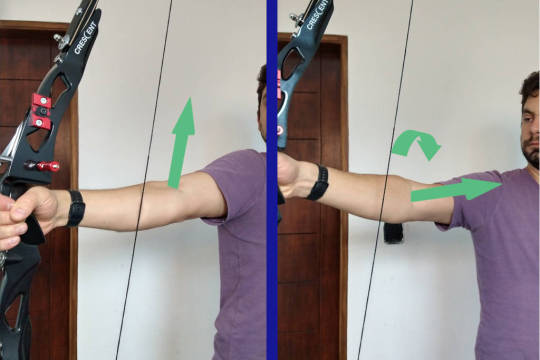
Holding the Bow
Your character shouldn’t have a death grip on the bow. Instead, show it resting in the curve between the thumb and index finger. Here’s a wikihow article that describes the different ways to hold different types of bows that is more succinct than I could ever be. Ignore the crossbow (derogatory).
Anchor
Everyone needs an anchor. What’s an anchor, you ask? An anchor is a fixed spot that you draw your string back to whenever you’re going to shoot. It’s necessary in order to ensure consistency, which is accuracy’s best friend. Your anchor spot can vary. I anchor at the corner of my lip. Some people anchor underneath their chin. Some anchor to their ear. I’ve even seen some people in Asian disciplines anchor behind the ear or almost above the head, which is incredibly impressive. Bottom line, unless your character’s archery discipline has them draw behind the ear or above the head, you need to have them touching their head somewhere. The only wrong anchor is a short anchor. If you can’t draw the string back far enough to touch your face, that means you’re either trying to draw back a bow with too high a poundage, or the draw length is too short for you. The picture above of the person with the compound trigger release has a good anchor point on their face. The picture of the person with the arm guard has a good anchor point under their chin.

This person, on the other hand? Their anchor is out in space, that is to say they don’t have one (also their elbow discipline, posture, and stance are atrocious). I see this in fanart ALL THE TIME. It’s a pet peeve of mine. Don’t do this, have them anchor to their head or behind it somewhere.
Carrying The Bow
The best way is to just carry it in your hand by the bow (not the string). You can give your character a bow sling, or a back mount like Legolas has as well. You can slip the string over your shoulder and wear it across your back in a pinch, though this may damage the string. The only really wrong way to carry a bow is by the string, though you can damage your bow carrying it on your back if you’re stupid, and I’ve never tried to do so with a compound. Too pokey.
TL;DR
If you’re drawing a fantasy character, go buck wild. Still make sure to give them the right type of arrowhead, hand protection of some sort, a strong stance (no kneeling or sitting), good posture, a sensible draw, elbow discipline, an anchor point (don’t be like the person above!), and a good way to carry their bow, but you can have fun with the rest. If you’re drawing a character from history, research the archery discipline they would most likely use, and draw them with the appropriate bow type, quiver, arrows, protective equipment, stance, posture, draw, elbow discipline, anchor, and bow carry.
#archery#legolas#legolas greenleaf#lotr#tauriel#katniss everdeen#merida#green arrow#hawkeye#clint barton#robin hood#archer#bows#art reference#len speaks#holy FUCK it's complete!#i spent like five hours researching for this post jfc i'm beat#me: *sees one terrible piece of legolas fanart*#me: *cracks knuckles* tiME TO INFODUMP#anyways in conclusion fuck cr*ssbows uwu
1K notes
·
View notes
Text
Recent reads #1.
In February, I formatted my wrap-up actually as a wrap-up, but I didn't really enjoy making myself write about every movie and every show and every audiobook, so I've decided to cut the movies and tv shows unless I specifically want to review one, and just do recent reads every ten books I want to talk about, ignoring rereads I have literally nothing to talk about, and not filling two of my weekly post slots per month first with a tbr, then with a wrap-up. I have other things to talk about.
So, here's ten books I read recently.

1. Skyward by Brandon Sanderson
Hoo. So I finally read this, and, ultimately, I did enjoy it, but it was about two hundred pages too long. I'm sure if the first three/four hundred were condensed, the characters wouldn't feel so developed, but I think it would be worth it to increase the pace. If the pace of this book were on a graph, it would be flat until the last fifty pages, at which point it would increase exponentially.
Anyway, to this book is set in a (technically dystopian) sci-fi future, in which humanity is living on a planet called Detritus, where the crew of a ship called the Defiant crashed during a battle with the alien race of the Krell. This was several generations ago, and for several decades, the original crew split into groups, because when in groups of over a hundred, the Krell could sense, attack and kill them. Fast forward several decades, after a huge battle, humanity now lives together again, partially on the surface. Skyward follows Spensa Nightshade, daughter of a coward from the Battle of Alta, when humanity came back to the surface. Spensa wants to be a pilot, to battle the Krell, defend humanity, and eventually escape past the debris field surrounding Detritus. Then she finds a ship. A ship, broken and run-down, but more advanced than anything humanity has, and fixable. And it talks.
I'm going to keep this one brief because I have a lot to say about this book, and am planning to make a full review, but for now: I was so bored throughout the first three hundred pages. I didn't particularly care about the characters--of whom I felt there were too many--and found Spensa irritating, which bothered me particularly because this book is written in first person. Then, events, action, character arcs, and I left this book absolutely desperate for the next. I think my main issue with this was just the amount of set-up required for the clearly epic saga Sanderson is planning
On the plus side, its sequel Starsight came out in November, so, if all goes to plan, that should be around the third or fourth book on this list.
Rating: um. Last hundred or so pages I feel deserve full five stars, but I think the first few hundred drag this down to about 3.73 stars, specifically.
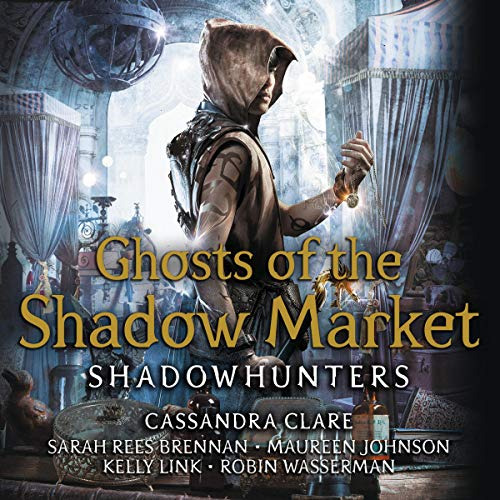
2. Ghosts of the Shadow Market by Cassandra Clare, Sarah Rees Brennan, Maureen Johnson, Kelly Link, and Robin Wasserman
Honestly, I wasn’t going to read this Shadowhunters novella bind-up. I haven’t read any of the other bind-ups. I only actually decided to read it because I was running out of audiobooks I wanted to listen to, and this was the only Shadowhunters bind-up on Audible. But I’m so glad I did.
So this novella bind-up is set in the world of the Shadowhunters and basically follows Jem Carstairs from the end of the Infernal Devices, up to its epilogue and then beyond. It was released after the Mortal Instruments, the Infernal Devices and the Dark Artifices, but before the Last Hours, the Eldest Curses and the Wicked Powers (obviously, because the Wicked Powers doesn’t even have a title for book one yet). The earlier novellas set up the Last Hours, the later ones the Wicked Powers, and probably the Eldest Curses, too, but I don’t really remember.
I didn’t enjoy the Mortal Instruments, and after reading City of Bones, I listened to the rest as audiobooks so I could read the other series, which I did love (even if I felt the Dark Artifices was unnecessarily long). Chain of Gold, the first book in the Last Hours has been out for just over a year now, and has definitely been the most hyped Shadowhunters book in the recent years, so I can’t wait to get to it, and am so glad I read this and got to know a little about the characters, though I don’t think you need to have read this to read Chain of Gold.
Rating: 4.3 stars. (Yes, apparently I’m doing decimals other than .5 now).
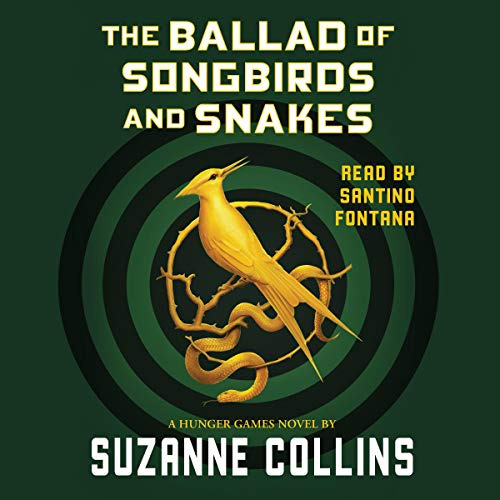
3. The Ballad of Songbirds and Snakes by Suzanne Collins
I finished this audiobook on March 19th, which says something about how my reading’s going this month. Actually, this is the fourth book I read in March 2021, because I also listened to the Mockingjay audiobook this month in my preparation to read this, but I didn’t think it was necessary to include it in this list because I’ve read it so many times before. Four books in twenty days isn’t bad--it’s more than most people read, but still. Especially when three of the four are audiobooks.
So, this book follows Coriolanus Snow, Panem’s president in the original series, as he acts as a mentor in the 10th Hunger Games. These Games are very different to the 74th we see in The Hunger Games, and every character in this book (minus the one character under the age of ten) was alive during the war. Since there have obviously only been nine Games before now, the tributes obviously couldn’t have victors from their districts as mentors the way Katniss and Peeta do, and this is the first year they have any form of mentoring. There’s no training, watching isn’t mandatory, this is the first Games in which they have sponsorships etc. Coriolanus is assigned the female tribute from district 12, and finds himself questioning his morality.
I really wasn’t sure what the point of this book was. It showed more inequality within the Capitol than what the trilogy exposed us to, but it didn’t seem to contain the same message as the Hunger Games, partly because Coriolanus essentially had a negative character arc, so as to become the tyrant, and partly because we knew how it would end. (Spoiler: Coriolanus falls in love with his tribute, but we knew it couldn’t work out because he couldn’t and wouldn’t marry someone from the districts, but he had a wife and daughter in the trilogy.) I don’t understand why Collins is trying to get us to sympathise with this villain--I love sympathetic villains, and anti-heroes, morally grey characters etc., but Snow just isn’t that in the trilogy, so it has little impact.
Granted, I did find the insight to his mind interesting, and the book was very entertaining--and had an excellent narrator--but I just didn’t see the point. I think this had the potential to garner five stars from me, but it just adds so little to the original story, I can’t do it.
(Leena Norms on YouTube made an excellent spoiler review on this book that goes much more in-depth about symbolism, themes etc. You can find it here)
Rating: 4 stars.
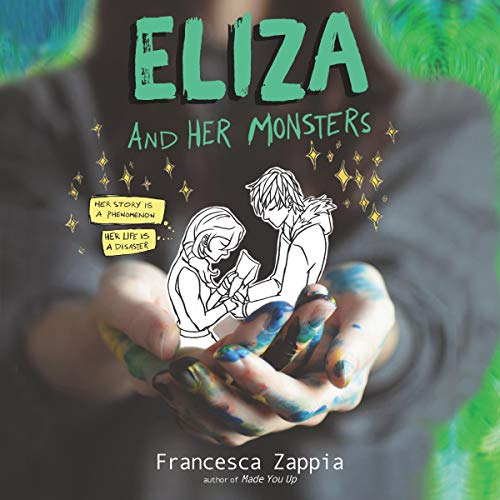
4. Eliza and Her Monsters by Francesca Zappia
I read this in three days. I’m not a huge contemporary person, but hell yes. This book? Mwah.
We follow Eliza Mirk, your typical teenage outsider. She hates high school, and is just waiting for graduation. Online, however, she’s LadyConstellation, the anonymous creator of the hugely popular web comic Monstrous Sea. Then she meets Wallace Warland, a Monstrous Sea fan who Eliza soon discovers is actually RainMaker, the most popular Monstrous Sea fanfiction writer. We have romance, we have geeky stuff, we have relatable hatred of school.
I listened to the audiobook (a running theme of audiobooks here, because I was currently very slowly reading House of Earth and Blood by Sarah J Maas, which is 800 pages. If your book’s going to be more than 600 pages, make it two books. Please.), which was a little disappointing because I later found out the book has Monstrous Sea comic strips in it, which are in the audiobook, you just don’t get the visuals. Regardless, the narrators were excellent, and I loved this as my intro to the contemporary genre.
Rating: 4 stars.
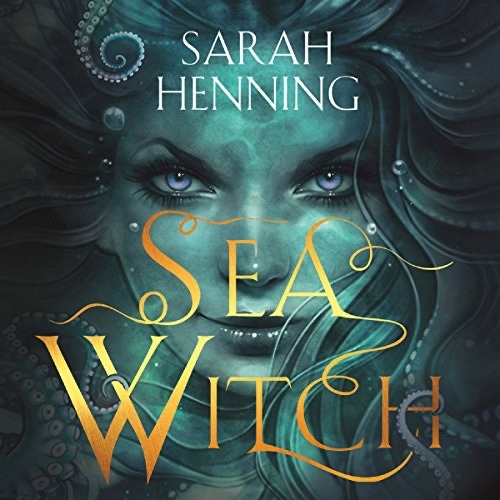
5. Sea Witch by Sarah Henning
This was the last book on my audiobook list before I gained a ton more, and though it wasn’t mind-blowing, it was enjoyable, and I do want to read the sequel. Or rather, listen to it.
This book takes place before the game of the Little Mermaid, and follows a young woman who will become the Sea Witch. One day, a girl drowns as her friends fail to save her. Three years later, a girl with nearly the same name arrives in her friends’ lives, though no-one but Evie recognises her, and Evie must help her get the prince to give her true love’s kiss to save her.
The plot wasn’t especially exciting and the characters weren’t especially interesting; the plot was rather predictable, but the writing was excellent and it was enjoyable nonetheless.
I’m curious as to where the sequel will go, because this book’s epilogue is set 50 years after the climax, but I assume it’ll be the retelling of the actual Little Mermaid story.
Rating: 3 stars.
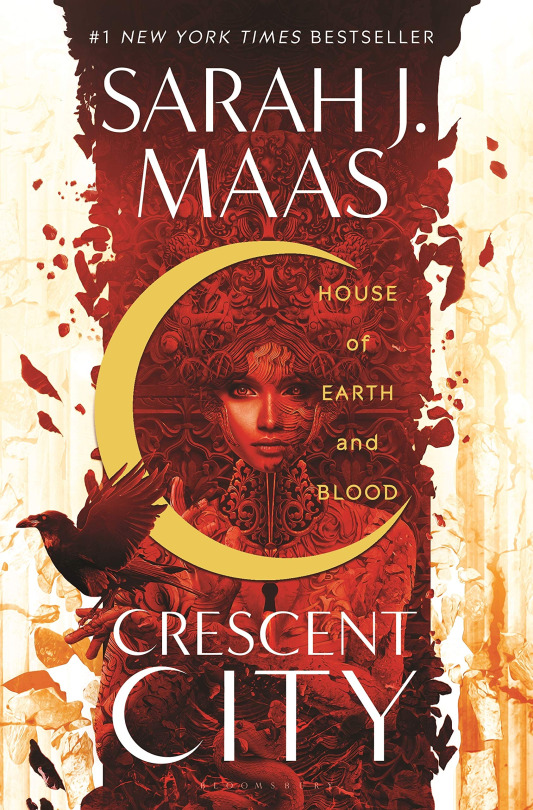
6. House of Earth and Blood by Sarah J Maas
I didn’t want to love this book as much as bookstagram does. In fact, over time, my love for Maas’s Throne of Glass and A Court of Thorns and Roses has faded, especially earlier this year when I listened to the Throne of Glass audiobooks (my second read through), and was struggling by the end, because it took itself way too seriously, and it felt like it was just continuing for the sake of it (I stand that the entire eight-book series could have been four or five books at most, and that’s including the prequel). In contrast, this just didn’t drag. I was intiially overwhelmed by the 800 pages, but, God, it was worth it.
The Crescent City series is set in a modern-day fantasy, with modern technology, but where humans, angels, shifters, fae, and a thousand other kinds of supernatural creatures, live side by side. Bryce Quinlan is half-fae, a party girl, living like tomorrow doesn’t exist, until her best friend, and her best friend’s wolf pack, are murdered. Two years later, a similar string of murders starts up again, though the supposed killer remains imprisoned, and Bryce is recruited by the city government to investigate, with the help of Hunt Athalar, an enslaved fallen angel, who Bryce is incredibly thirsty for.
I made notes while reading this. I had many thoughts, throughout 800 pages.
Maas just really wants to write kind-of-fae protagonists: every one of her books (bar Catwoman: Soulstealer) has a protagonist who isn’t always entirely human, and who isn’t always entirely fae.
It felt like this was only classed as adult instead of young adult so she could use the word ‘fuck’ three times per page--her previous books being young adult didn’t stop her writing graphic smut scenes.
In the first three hundred pages, the main cast walked into the road and halted traffic so many times (being like twice)--Jesus, can we just let the poor drivers be?
This book never really explains the Gods in this world. There’s so much lore, and worldbuilding, but the Gods are never really explained.
Lehabah’s character reminded me so much of Iko from The Lunar Chronicles by Marissa Meyer, and I am so here for it.
‘...Bryce mused, toying with her toes. They were painted a deep ruby. Ridiculous, he told himself. Not the alternative. The one that had him imagining tasting each and every one of those toes before slowly working his way up those sleek, bare legs of hers.’ Right, so the Umbra Mortis has a foot fetish.
Looking back through my notes, I made this one--’I get that it’s more fun to write attractive characters, but not every no-name needs to be drop dead gorgeous’--which is hilarious to look back on because the character I was specifically referencing turned out to be a very big name, but still.
I did enjoy every second of this book, but I still think it could have been condensed. God only knows how many words were in the first draft of this book.
A lot of the words for things in this--Midgard for Earth/the mortal world; Vanir for the supernatural creatures--are from Norse mythology, and I’m so here for it.
By the time the actual truth of the mystery came out, I’d already been given so many assumptions and alternatives as to what happened, that, having finished the book, I can barely remember the actual truth. We were given at least four versions of the story.
Finally, Bryce and Hunt spend literally this entire book lusting after each other, and we hear about their fantasies about each other at least twenty times, but they literally never have actual, penetrative sex. There are explicit scenes, sure, but the most action for himself Hunt gets is alone in the shower.
Anyway, I loved this. It was 1000% better than previous books by Maas, and I want book two immediately. (Maybe not immediately; I’d like to read other books, but still.) I finished it on March 31st, and it was my 30th read of the year, actually completing my Goodreads goal for the year--it was intentionally low because I only read 23 books last year, but in the shortest quarter of this year, I already met my goal. I’m leaving the Goodreads official goal at 30, because I don’t want to push myself too far, but I have a silent goal of 100--if I keep up this pace, I can read about 122 books, but we’re going to keep quiet, because I sincerely doubt I’ll manage that.
Rating: 5 stars.
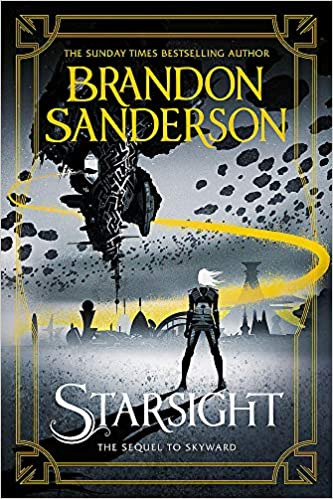
7. Starsight by Brandon Sanderson
God, this surpassed Skyward. I think part of that is because I already knew a lot of the characters, and Spensa is significantly less annoying in this one. It follows an incredibly different storyline to the first, but still has the same vibes, and was, frankly, a fantastic sequel.
I will say this series reads very young, and it’s very difficult for me to imagine the characters as adults.
Also, called the romance, and they kiss in this one, and it’s actually very anticlimactic. The two characters are in completely different places for most of this book, so there’s not much development, but my God.
This book, this world... ahhhhh. If you don’t like science fiction, you won’t like this series, but otherwise, just read it. You won’t regret it.
Rating: 4 stars.
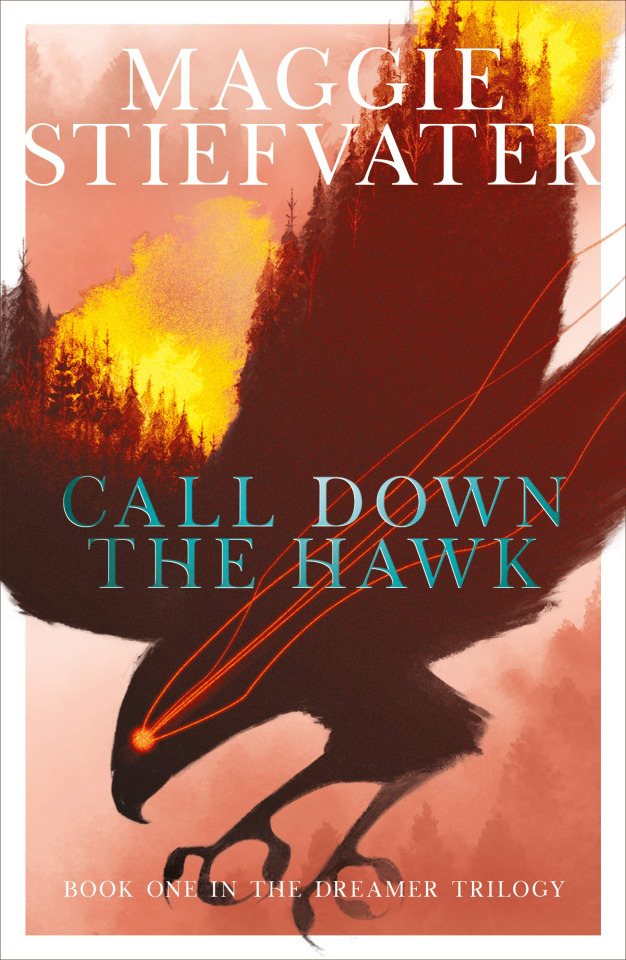
8. Call Down the Hawk by Maggie Stiefvater
First off, I love the US cover for this, but the UK one is so much better, and you can fight me on that.
This is the first book in the Dreamer Trilogy, a sequel series to The Raven Cycle, centred on the wonderful Ronan Lynch. The existence of this book was actually why I decided to reread The Raven Cycle--I listened to the audiobooks in, I think, 2018, and didn’t pay a huge amount of attention, which was, in retrospect, a horrible idea, given how complicated the storyline is, but I wanted to read this series, so a reread was required. And, as we know, I’m so glad I did, because I absolutely fell in love.
I do wish this book had more of the other Raven Cycle characters--you’ve obviously got Ronan and his brothers, and Opal, but there was so little Blue, Gansey and Adam. Adam was actually in quite a few scenes, but he’s my least favourite of the main four; Gansey had some texts and Blue had a single phone call, except that chapter was from Declan’s perspective, so we only got Ronan’s end.
Regardless, Stiefvater, as usual, introduced some amazing new characters, more worldbuilding, and I love the way she gives the antagonists’ perspective, too. There’s about a month, as of today, before the sequel comes out, and, fair to say, I can’t wait.
Rating: 4.2 stars.

9. A Court of Silver Flames by Sarah J Maas
I hate this cover change. Utterly inferior to the original covers.
In all honesty, my love for SJM has faded over the last few months--though I do now think House of Earth and Blood may have revived it--but I did still enjoy this. So now let’s go through the notes I made as I went!
First off, though, this is the fourth book in the A Court of Thorns and Roses series, focusing on Nesta and Cassian, but I’m not saying anything else so as to avoid spoiling the first three.
The opening reads like fanfiction. The introductions, the inciting incident--I’ve never been a huge fanfic reader, but this reads like fanfic setup.
SJM’s apparently going on a Norse mythology surge, what with Vanir in Crescent City and Valkyries here, but I’m really, really here for it
Elain Archeron feels irrelevant. She has imapct on Feyre and Nesta, sure, but she has no agency of her own. People ship her with Azriel, solely because she’s the unmated Archeron sister; he’s the unmated bat boy, but I’m not sure how I feel about that.
I sincerely hope we get more context as to Amren’s origins. There was a little in this, but not enough to satisfy me.
SJM has an obsession with masculinity. Little to a fault, honestly--every one of her male characters in described in some way, shape or form as the epitome of masculinity and ‘male arrogance’, and it irritates me to no end. Honestly, her books all feel like vessels for a sub/dom kink. Just saying.
‘As if she’d been freed from a cage she hasn’t realised she’d been in.’ I didn’t make note of it, but she this was the second time Sarah tried to test whether or not we’d notice this blatant manipulation of the ‘breath they didn’t realise they were holding’ cliche.
Stop capitalising the word ‘Made.’ It’s really not that difficult, and it’s ugly.
And as for the 70% of this book that is purely smut: hate that Nesta’s scent was disguised because Cassian’s ‘essence’ was all over her. What does that mean and why does even her scent submit to him??
Literally all of her female characters fall into the minority of women capable of orgasm from purely penetrative sex: it’s unrealistic, and I’m not entirely convinced SJM understands how the female body works. Also, in both this and Crescent City, she kept saying ‘her breasts pebbled’, and I still have no idea what that means.
I did, however, really enjoy seeing the Winter Solstice celebrations again.
I enjoy the smutty scenes as much as the next reader, but the latter fifth of this book, when they finally stopped shagging and got on with the plot, were so much better than the earlier ones.
Regardless, I did really enjoy this book, and come out with a hugely positive opinion, mostly because I enjoyed the last hundred pages so much.
Rating: 4.1 stars.
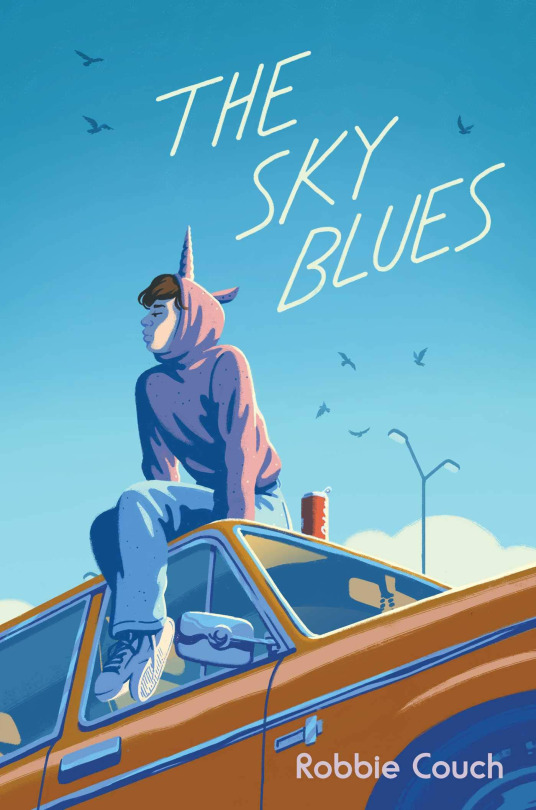
10. The Sky Blues by Robbie Couch
I cannot get Robbie Couch’s name right. I keep thinking it’s Crouch, and I don’t know why. Anyway.
This was the Booksplosion book of the month for April, and is very much not my typical thing. I am, however, trying to branch out my reading from purely fantasy and sci-fi, so here we are.
This book follows Sky Baker, an openly gay high school senior in Michigan, who is planning a promposal for his crush. Who may or may not be straight. Then, his promposal plans are exposed to the school in a homophobic, racist email-blast. That’s basically it, which doesn’t seem to me like a lot, but then most books I read aren’t 300-page standalones.
The narrative is a little cliche. We get an appearance-by-mirror on page four, which didn’t exactly give me much faith. There were, of course, also the times Couch pretended he wasn’t using the let-out-a-breath-they-didn’t-realise-they-were-holding cliche: ‘took a burden off my shoulders I hadn’t even realised was weighing me down.;’ ‘a million pounds I hadn’t even realised had been weighing me down for days.’ A nice metaphor, but cliche nonetheless.
It contains so many pop culture references, which are really entertaining in 2021, but will probably really date this in a few years.
Also, minor spoiler: we didn’t even get to see the actual prom. There was the whole build-up to it, the month before, the weeks before, the day before, and we never even got satisfaction.
Regardless, this was an easy, wholesome read, and I think it’ll be a good part of my entry to the world of contemporary.
Rating: 4.1 stars.
And those are my recent reads.
#blog#blogging#blog post#blogpost#blogger#bookblogger#bookblr#reading#ya#reader#ya books#young adult#wrap up#tbr#reading wrap up#writer#writing#writerblr
1 note
·
View note